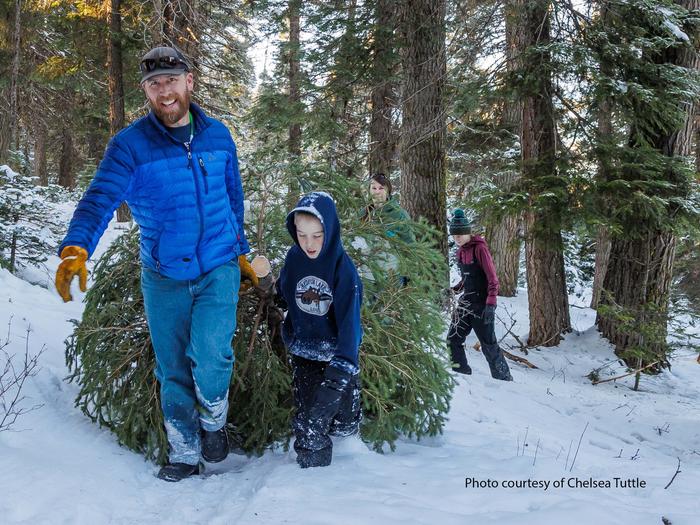Payette National Forest Christmas Tree Permit
Christmas Tree permits for the Payette National Forest are now available!
This permit allows you to cut a Christmas Tree within designated areas of the Payette National Forest! Lifelong memories are built during these special times and we are happy to help with any information gathering you'll need to make this trip a safe and enjoyable one.
Please be sure to read and agree to all the tips and guidelines when selecting your tree.
Additional information is available on the Payette National Forest website:
- Christmas Tree Info on the Payette National Forest website.
- Know where to go with the Motor Vehicle Use Maps
- Note: you can use the Avenza Map app to download the MVUM to your phone or other smart device.
Need to Know
Selecting Your Tree
Each forest has limitations on the size of the tree you can cut and the species of trees that are permitted. See below to help you measure and choose a tree that meets your permit's guidelines.
Tree height maximum is 12 feet.
Take the whole tree. Do not remove the top of the tree; cut down the entire tree.
Cut your tree off below the lowest live limb and within six inches of the ground surface (not the snow surface).
Where to Cut Your Tree
Do not cut trees within wilderness areas, timber sales, and areas that have been planted with new trees.
Do not cut trees within sight of highways, campgrounds or other recreation sites, private lands, and administrative sites.
This permit is only valid on the Payette National Forest. Know where you are. Taking trees from private or State lands that are within National Forest boundaries is not allowed with this permit.
Roads are usually slippery and not plowed. Conventional two-wheel drive vehicles will not be able to drive most roads.
See the Motor Vehicle Use Map (MVUM), which highlights the routes on the Forest where wheeled-motor vehicles are allowed to travel. The MVUM is available here: https://www.fs.usda.gov/main/payette/maps-pubs.
Planning Your Trip
Helpful Cutting Tips
Carry your tree carefully out of the woods. Dragging the tree will rub off needles and bark.
If the tree is too big to transport inside of your vehicle, wrap it in canvas to prevent wind damage.
Once home, cut the bottom of the trunk off and place the freshly cut trunk in a bucket of water. Replenish water.
If storing your tree outside for a few days before putting it in the house, keep it in an area protected from the wind, such as the north or east side of your house or under a shaded tree.
Tools you might want to consider bringing with you include a measuring tape to ensure you select a tree that fits in your home; handsaw to cut your tree; gloves to protect your hands; boots to protect your feet; a tarp to sit on and/or to move your tree once it's cut; and rope or straps to secure your tree to your vehicle.
Choose a tree from a dense forested area, which will give the remaining trees more space to grow.
Cut the leftover branches from the stump and scatter them.
How to Plan Your Trip
Before you leave home, be sure to measure the space where you plan to place the tree in your home (height and width), and measure the space in your vehicle where you will be transporting the tree.
Cell service may be spotty or unavailable. Be sure someone knows where you are and when to expect you back.
Check the latest weather conditions, forest warnings and road closures before you leave on your trip. Bring plenty of food and water with you as well as an overnight survival kit in case you become stranded. Start your day early. Be sure to find your tree and leave the woods before dark. Dress warmly and take extra dry clothes. Expect winter weather, including cold temperatures, snow and winds. Bring a map with you. Don’t rely on GPS because it may not be up-to-date with forest service roads.
Be prepared for the possibility of a long hike or snowmobile ride while searching for the perfect tree.
Roads may not be plowed. Carry tire chains, shovel(s) and a tow chain. Be sure your vehicle has a full tank of gas. Bring a spare key and give it to someone else in your party. Don’t get locked out of your car! Park in areas so that traffic can get by safely, and do not block gates.
According to Idaho state law, any vehicle carrying a load that extends more than 4 feet past the tailgate, must display a red or florescent orange flag tied on the end of the load to caution other drivers.
